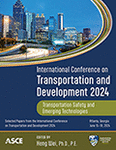Automated Vehicles vs. Human Drivers: Modeling Driving Behavior Using Data from Field Experiments
Publication: International Conference on Transportation and Development 2024
ABSTRACT
As automated vehicles (AVs) gradually gain prevalence on public roads, understanding their distinctive driving behavior is crucial for traffic management and planning. This study conducted field experiments using an SAE Level-3/4 AV and collected driving data of AVs and human drivers on public roads using sensors including GPS, radar, camera, and LiDAR. The Wilcoxon rank-sum test is used to identify the difference in the behavior between AVs and human drivers. In addition, logistic regression and Extreme Gradient Boosting (XGBoost) are used to classify AVs and human drivers. Results suggest that there exists a significant difference in driving behavior between AVs and human drivers. Moreover, features including the mean speed and the distance from the vehicle to the detected objects are positively related to the probability of the vehicles being AVs, while the standard deviation of speed and the mean acceleration are negatively associated with it. Furthermore, XGBoost accurately identifies AVs and human drivers using the extracted features with an average area under the curve of 0.92. Results from interpreting results from XGBoost indicate that it performs better when the mean speed is either in the low or high ranges. Moreover, AVs and human drivers are hard to differentiate using the model when the vehicle is too far from other objects. This study underscores the substantial divergence in driving behavior between AVs and human drivers, offering valuable insights for the evaluation of the impact of AVs on traffic conditions.
Get full access to this chapter
View all available purchase options and get full access to this chapter.
REFERENCES
Beauchamp, É., Saunier, N., and Cloutier, M.-S. (2022). Study of automated shuttle interactions in city traffic using surrogate measures of safety. Transportation Research Part C: Emerging Technologies, 135, 103465.
Chawla, N. V., Bowyer, K. W., Hall, L. O., and Kegelmeyer, W. P. (2002). SMOTE: synthetic minority over-sampling technique. Journal of Artificial Intelligence Research, 16, 321–357.
Chen, T., and Guestrin, C. (2016). Xgboost: A scalable tree boosting system. Proceedings of the 22nd Acm Sigkdd International Conference on Knowledge Discovery and Data Mining, 785–794.
Eren, H., Makinist, S., Akin, E., and Yilmaz, A. (2012). Estimating driving behavior by a smartphone. 2012 IEEE Intelligent Vehicles Symposium, 234–239.
Fuest, T., Feierle, A., Schmidt, E., and Bengler, K. (2020). Effects of marking automated vehicles on human drivers on highways. Information, 11(6), 286.
Jayaraman, S. K., Creech, C., Tilbury, D. M., Yang, X. J., Pradhan, A. K., Tsui, K. M., and Robert, L. P., Jr. (2019). Pedestrian trust in automated vehicles: Role of traffic signal and AV driving behavior. Frontiers in Robotics and AI, 6, 117.
Li, P., Abdel-Aty, M., and Yuan, J. (2021). Using bus critical driving events as surrogate safety measures for pedestrian and bicycle crashes based on GPS trajectory data. Accident Analysis & Prevention, 150, 105924.
Linkov, V., Zaoral, A., Řezáč, P., and Pai, C.-W. (2019). Personality and professional drivers’ driving behavior. Transportation Research Part F: Traffic Psychology and Behaviour, 60, 105–110.
Lundberg, S. M., and Lee, S.-I. (2017). A Unified Approach to Interpreting Model Predictions. In I. Guyon, U. V. Luxburg, S. Bengio, H. Wallach, R. Fergus, S. Vishwanathan, & R. Garnett (Eds.), Advances in Neural Information Processing Systems 30 (pp. 4765–4774). Curran Associates, Inc. http://papers.nips.cc/paper/7062-a-unified-approach-to-interpreting-model-predictions.pdf.
Mahadevan, K., Sanoubari, E., Somanath, S., Young, J. E., and Sharlin, E. (2019). AV-Pedestrian interaction design using a pedestrian mixed traffic simulator. Proceedings of the 2019 on Designing Interactive Systems Conference, 475–486.
Palmeiro, A. R., van der Kint, S., Vissers, L., Farah, H., de Winter, J. C., and Hagenzieker, M. (2018). Interaction between pedestrians and automated vehicles: A Wizard of Oz experiment. Transportation Research Part F: Traffic Psychology and Behaviour, 58, 1005–1020.
Remonda, A., Veas, E., and Luzhnica, G. (2021). Comparing driving behavior of humans and autonomous driving in a professional racing simulator. PLoS One, 16(2), e0245320.
Soni, S., Reddy, N., Tsapi, A., van Arem, B., and Farah, H. (2022). Behavioral adaptations of human drivers interacting with automated vehicles. Transportation Research Part F: Traffic Psychology and Behaviour, 86, 48–64.
Toledo, T., Koutsopoulos, H. N., and Ben-Akiva, M. (2007). Integrated driving behavior modeling. Transportation Research Part C: Emerging Technologies, 15(2), 96–112.
Wen, X., Cui, Z., and Jian, S. (2022). Characterizing car-following behaviors of human drivers when following automated vehicles using the real-world dataset. Accident Analysis & Prevention, 172, 106689.
Wikipedia. (2023). Receiver operating characteristic. https://en.wikipedia.org/wiki/Receiver\_operating\_characteristic.
Woolson, R. F. (2007). Wilcoxon signed-rank test. Wiley Encyclopedia of Clinical Trials, 1–3.
Zhao, X., Wang, Z., Xu, Z., Wang, Y., Li, X., and Qu, X. (2020). Field experiments on longitudinal characteristics of human driver behavior following an autonomous vehicle. Transportation Research Part C: Emerging Technologies, 114, 205–224.
Information & Authors
Information
Published In
History
Published online: Jun 13, 2024
Authors
Metrics & Citations
Metrics
Citations
Download citation
If you have the appropriate software installed, you can download article citation data to the citation manager of your choice. Simply select your manager software from the list below and click Download.
